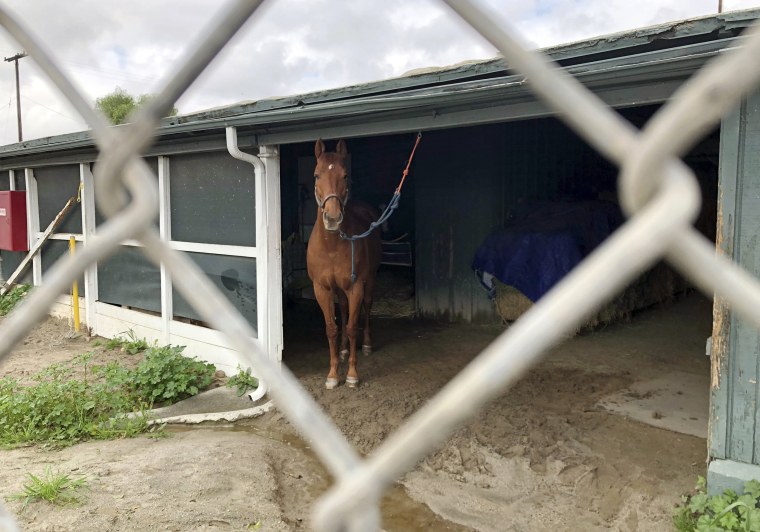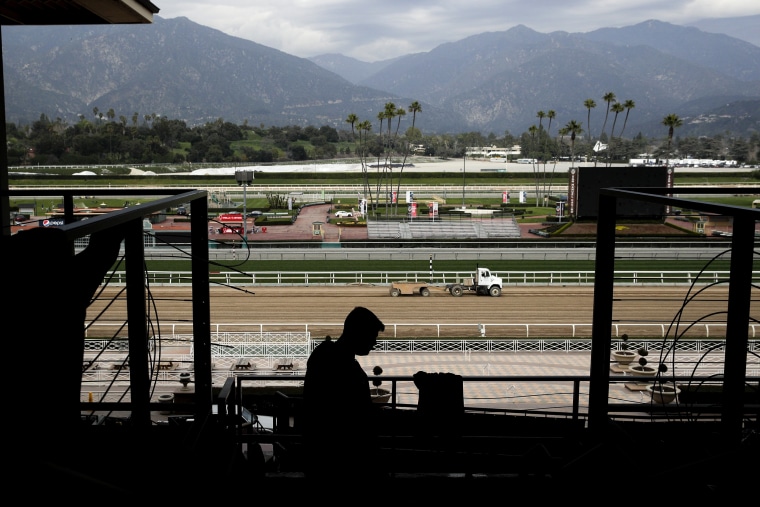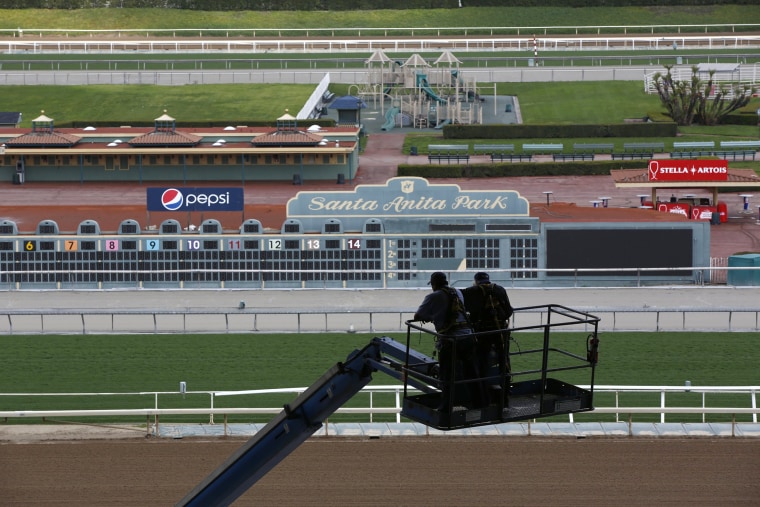One horse death followed another at Santa Anita Park, a racetrack for thoroughbreds outside Los Angeles. In the past month, the track was shuttered for testing and repairs, then reopened and declared safe, then quickly shut down again after the deaths continued, reaching 21 earlier this week — more than double the total for last racing season.
“It’s been tough on everybody, just from a morale standpoint,” said Ray Paulick, owner of the Paulick Report, a website for horse racing aficionados. “I don’t know anyone in this business who doesn’t love horses, and to see this happen has been a demoralizing thing.”
Santa Anita Park officials are working to discern the cause of these deaths, but no clear pattern has emerged — leaving questions from industry insiders, veterinarians and animal rights activists about whether the condition of the dirt track, the treatment of the horses or the pressures of the sport itself are to blame for the spike in fatalities.

As the investigation continues, Santa Anita reopened an inner training track on Friday so horses can stay active. The Stronach Group, which owns the racetrack, said in a press release on Friday that it has it hired additional veterinarians, as well as created a new director of equine welfare position to oversee horse welfare and injury responses. Trainers will also be subject to more regulations.
But racing remains suspended indefinitely at the busy track, delaying events including the Santa Anita Handicap, the track’s biggest race of the year with a $600,000 purse.
While the recent deaths have drawn renewed attention to the dangers facing racehorses, experts and animal rights advocates note that they are not an anomaly in a sport that often pushes animals to their limits.
When horses fall during a race, Dr. José García-López, director of equine sports medicine at Tufts University Cummings School of Veterinary Medicine, said it’s comparable to “a person getting hit by a car.”
“For a horse, the threshold between being injured and non-injured is very, very small,” he said. “It’s a tight balance. Horses have a number of things that count against them.”
SANTA ANITA’S DIRT TRACK
Much of the scrutiny at Santa Anita has focused on its main dirt track, which was inundated with unusually heavy winter rains — more rain has fallen in Los Angeles in the past four months than it usually gets all year— making the hard-packed earth more difficult to maintain.
“When I see something like this, at one particular track, the first thing that comes to my mind is there has to be a problem with the surface,” García-López said.
Santa Anita seals its track after every rainstorm by tightly packing dirt to prevent rain from soaking in. But some trainers believe the process makes the track too hard and unforgiving for animals that weigh more than half a ton and run on spindly ankles.
On Thursday, tractors dragged a harrowing machine over the Santa Anita track to loosen and aerate the soaked soil.
Paulick noted that the heavy wetness this winter came as the track’s longtime overseer, Dennis Moore, stepped down.
“I think those factors and terrible luck are likely the causes,” Paulick said. He visited eight trainers at the track on Thursday said all agreed the closure and investigation was necessary, if unfortunate.
The Stronach Group said that Moore had returned Thursday to lead the formal testing of the 1-mile main track.
“Measures will include utilizing an Orono Biomechanical Surface Tester, a device that mimics the impacts of a horse running at full gallop, allowing engineers to see how the track holds up,” The Stronach Group said in a statement posted online. “These test results will be evaluated to ensure track consistency and uniformity for both training and racing.”
All safety measures at the track will also be reviewed, the group said.
THE ROLE OF MEDICATION?
While racing insiders have zeroed in on weather and the condition of the track, some experts and animal rights activists have spotlighted a broader issue in horse-racing: the injuries and deaths that can occur when horses are over-medicated with painkillers and anti-inflammatories.
A 2012 New York Times series found that 24 horses died each week at racetracks around America, many due to over-medication and poor oversight. After reforms by state racing regulators, the death rate has declined in recent years.
Necropsies are still pending on the horses that have died at Santa Anita, so it’s currently unknown whether drugs may or may not have contributed to the deaths.
But People for the Ethical Treatment of Animals (PETA) and other groups say too many horses are still dying, because, they say, horses are over-medicated and veterinarians and handlers can’t tell when they are injured. The horses are then allowed to train and race, aggravating those injuries, potentially fatally, PETA said.

PETA called for Gov. Gavin Newsom to close Santa Anita and sent a letter to the Los Angeles County district attorney calling for an investigation into the over-use of drugs. Newsom and the DA’s office did not immediately respond to requests for comment.
Dr. Kevin Keegan, a veterinarian and professor of equine surgery at the University of Missouri’s Veterinary Health Center, countered PETA’s claim and said that blaming overmedicating is a “popular legend.”
“It isn’t because the horses are given pain-relieving drugs,” he said, noting that there are strict regulations that prohibit horses from taking medication on race days, even if it’s antibiotics for an infection.
Keegan said nobody knows exactly why the deaths are occurring but that it seems like a “situational problem.”
The California Horse Racing Board has extensive regulations about medications that are allowed for afternoon workouts for horses. The board’s Medications Committee will take up stricter limits on medication of horses during morning workouts at a meeting in April.
The horse racing regulators are also expected to move forward with stricter penalties for improper use of medications, said Mike Marten, a spokesman for the board.
García-López said that, as in human athletes, anti-inflammatories and joint injections can be extremely helpful if used judiciously on horses. If abused, the medicine can prove “catastrophic.”
“If you abuse anything, you can get in trouble,” he said.
HOW TO TELL WHEN A HORSE IS OVERWORKED
The Santa Anita deaths are far from the only ones to hit horse racing in recent years.
Regardless of what was to blame in this case, experts said it remains unclear why racehorses generally suffer fatal injuries so often.
“The big debate in equine veterinary medicine is what is the cause of these breakdowns,” Keegan said.

Dr. Shannon Reed, a veterinarian and associate professor of equine surgery at Ohio State University, said that research is needed to determine which horses are particularly vulnerable to catastrophic injuries before they race, based on previous injuries that may not have healed properly.
“Researchers are studying: How do we figure out if horses have normal wear and tear or accelerated wear and tear?” Reed said. Veterinarians think bone scans and testing joint fluid to evaluate the overall health of the animals could be one answer.
Reed added that veterinarians are trying to learn more about the fetlock joint, which functions similarly to a human’s ankle and is often the site of fatal injuries for horses.
García-López said that as trainers improve horses’ nutritional and feeding habits and learn how to make the animals stronger than ever, there’s more room for risk. “It could potentially backfire,” he said. A stronger horse is heavier and “more prone to injury.”
Keegan added that there is reason to wonder if overworking the horses is partly to blame.
“In racing, like almost every sport, records and times keep getting better and better,” he said. “Is it because the athletes are getting better or are they reaching the biomechanical limit of the horse?”
James Rainey reported from Los Angeles. Ben Kesslen reported from New York.

